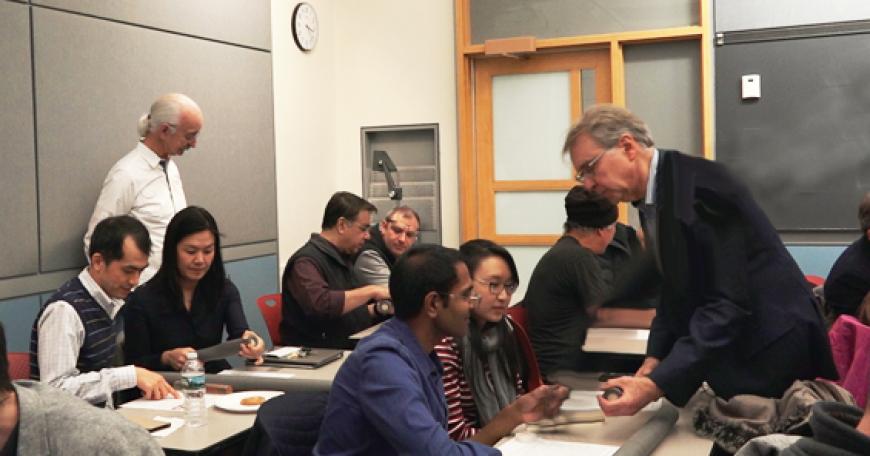
Hands-on Learning with Prof. Ely Sachs
When I first walked into the room, I paused. Tables were split up with people grouped around each table, which held two foam tubes, a measuring tab, a rubber cube, and an instruction sheet. I was puzzled and frankly quite surprised, as I had been to multiple xTalks in the past, but none like this. I soon learned that I would have a hands-on experience learning with Professor Emanuel “Ely” Sachs’ guided discovery teaching method at his Dec. 6 xTalk.
Guided discovery is a way to enable students to play a more active role in their learning. It allows students to essentially “discover” new material as if they were the first ones to come to these conclusions, and is particularly useful when they have not been exposed to it before. In addition, the presence of a guide allows students to benefit from exploratory learning without the risk of wasting time in directions that don’t add value. This xTalk with Prof Sachs took materials from a 2.001 (Mechanics and Materials I) class on shear strain. Shear strain occurs when a stress is applied parallel to the face of an element, changing the angle of two line elements that were originally perpendicular in the original element. I was unfamiliar with shear strain was before attending Professor Sachs’ talk, so this was a particularly enlightening experience for me to see what it would be like to go through this guided discovery during class.
Working with my partner, we followed the provided instruction sheet in order to learn what exactly shear strain was, and derive a formula for it. We predicted what would happen when we twisted the foam tubes at 90 degree angles, and observed what happened when we did so, analyzing whether our predictions matched reality and why. As would be done in a 2.001 class, which this seminar was based on, Professor Sachs periodically brought the class together to discuss what had happened and our reasoning for it. This method of learning created cognitive dissonance as we sometimes had to face the fact that our predictions did not match the observed reality. By interacting with the materials and being forced to discover the knowledge myself, I found it much more engaging and useful in learning what shear strain is and how it works.
Having not known what shear strain was before the talk but walking away with an understanding of what it is, how it is different from normal strain, and what factors affect shear strain, it is safe to say that this method of guided learning was successful. Guided learning allows students to not only solidify the fundamentals, but more importantly gain the ability to recreate knowledge as a result of gaining a clearer understanding of the material. It trains students in inductive reasoning, rather than deductive reasoning – the more common instruction in classrooms - and has even been shown to be robust against instructor, instructor experience, and class size.
It is often easy for students to attend class and leave without a greater understanding of the material. I have admittedly often walked out of lectures myself not fully understanding what had occurred because I was not fully engaged the whole time. However, when students play an active role in their learning, it is much easier to both pay attention and retain the information that is taught. This can have great implications for students’ learning, as more guided discovery in classrooms can enable students to truly understand the material and grasp fundamental concepts that they will use even after leaving MIT.
 Melissa Cao is an MIT junior majoring in management
Melissa Cao is an MIT junior majoring in management
About xTalks:
xTalks: Digital Discourses is a seminar series to facilitate awareness, deep understanding and transference of educational innovations at MIT and elsewhere. xTalks forums share strategies, solutions, and issues related to transformation in educational practice, particularly through the use of digital technologies.
Explore upcoming xTalks, as well as archives of past events with video, audio, and slides. To sign up for the xTalks mailing list, click here.

